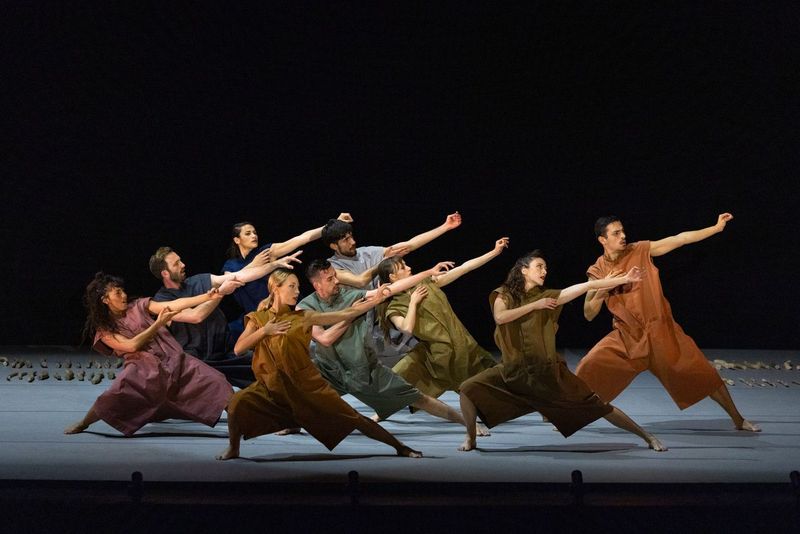
MAKOM – Vertigo Dance Company. Choreographed by Noa Wertheim and Rina Wertheim-Koren. Music by Ran Bagno; Lighting Design by Dani Fishof-Magenta; Costume Design by Sasson Kedem; Stage Design by Zohar Shoef. Presented by Celebrity Series of Boston at the Boch Center Shubert Theatre. Run has ended.
By Shelley A. Sackett
Renown Jerusalem-based contemporary dance company Vertigo does much more than its modest claim of “exploring the creative process.” Artistic Director and Co-Founder Noa Wertheim’s newest work, MAKOM (Hebrew for “place”), breaks new ground with its exciting blend of storyline, emotion, sound, and movement. The result is an evening-length journey that takes us to a deep place within and without ourselves, where language is more than words and meaning is more than content.
If that description sounds a little trippy, it’s because Wertheim and her spectacular troupe of nine dancers defy pigeonholing and quotidian dance performance vernacular. Wertheim listens to the movement of her body, watches her dancers improvise, and builds the choreographic narrative from that core out. Her overlying concept evolves from the movement, bottom-up rather than top-down.
She is keenly observant and deeply introspective, committed to earthly and spiritual elements, and the rich work she creates is nothing short of magic. Only after she has finished the choreography does she invite composer Ran Bagno to create musical accompaniment. The synchronicity of sound and movement that results is exceptional.
MAKOM can mean a real or imaginary place, and to Wertheim, it is a spiritual refuge, a home away from the fray of polarities and conflict where inner equilibrium opens the door to unity and collaboration. Connection, awareness, paying attention and the freedom to reject order are the main ingredients. Mysticism and meditation add intoxicating spice.
In MAKOM, wooden sticks are the only props. The backdrop is black matte and the dancers are clad in sack-like costumes of muted earth tones. Throughout the piece, they come together and then drift apart, undulating like water one moment and exploding like crackling flames the next.
There is joy, whimsey, and extraordinary talent in the choreography and its execution.
Thanks to spot-on lighting and sound, the dancers are the focus. Wertheim uses their bodies (especially the intertwining and draping of arms and hands) to create organic wholes out of many parts. Hers is a true company. While there are standout individuals (Sian Olles is impossible to look away from, even when hidden in the back, which — thankfully — she rarely is), there is no showboating or acrobatic theatricality. These nine dancers seem to share a single heartbeat.
Duets, in particular, focus on the push-pull fluidity of relationships as partners drift in and out of solos and various dyads. Dancers caress each other with tenderness one moment, then leap apart and drag one another across the floor.
Olles and Tommaso Zuchegna are particularly enthralling in a gorgeous pas de deux that is both simple and dramatic. Olles is like quicksilver, and she uses every molecule of her impossibly lithesome body to mesmerize and enchant. When she and Zuchegna interweave their arms and move in and out of the spotlight, the luminosity of their limbs creates a magical forest where humans and nature truly are one.
Towards the end, the captivating Olles sheds her outer garment and dances in a thin, delicate white slip. In a dramatic turn, other dancers collaborate to assemble a makeshift ladder out of the prop poles, which Olles balances atop and hinges over. The effect is simultaneously of calm and turmoil, togetherness and individuality, strength and weakness.
When the dancers dismantle the ladder, they construct the beginning of what becomes a bridge. Tentatively, some hold hands. Some explore the bridge, crawling up from opposite ends to meet in the middle and form a single, symbiotic unit. Some practice coupling, parting, and recoupling.
Finally, in a burst of hope, joy, and community, all nine join hands and dance together, encircling the bridge that will allow them to return to their makom, that place of balance and peace.
Wertheim has spoken eloquently about the need for humans to strive for the unity and wholeness that speaks to the fundamentals of the human condition. With MAKOM, through movement rather than words, she has shown us one path that can lead us to that place that brings us closer to ourselves by bringing us closer to ourselves.

